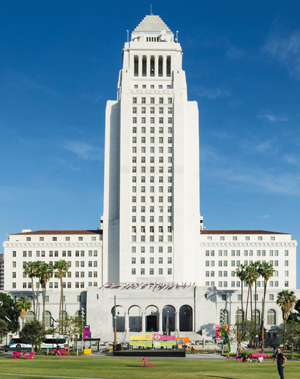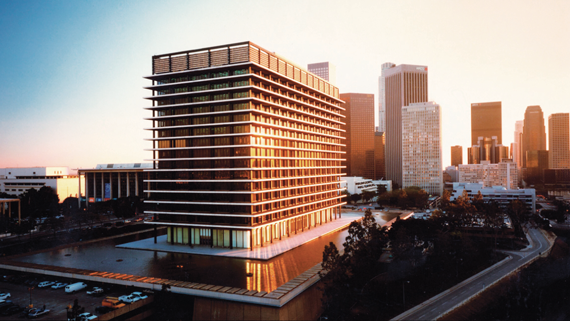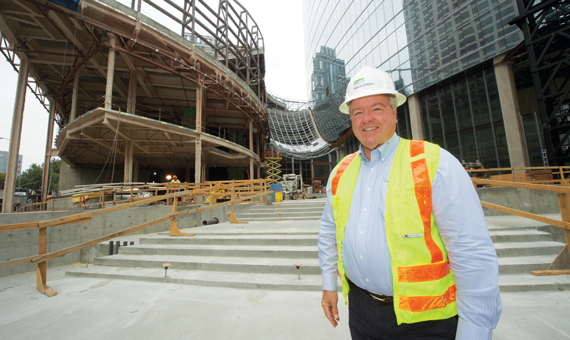Christopher Martin is a dyed-in-the-wool Angeleno. His father and grandfather both had long, productive careers as L.A. architects, and many of his own commissions have been centered in and around Los Angeles County. He has designed large public projects for clients such as the Los Angeles Police Department and the County Justice System, as well as academic buildings at institutions such as the California Institute of Technology and the University of Southern California. His son is also in the family business, making AC Martin a fourth-generation firm.
Now, Martin has reached a pinnacle in his career with the topping off of the tallest building west of the Mississippi. But the accolades this has brought certainly haven’t gone to his head. In fact, he said he didn’t realize that the height of the Wilshire Grand — 1,100 feet — would set a new record until an L.A. Times reporter brought this to his attention.
He does have a goal: He wants every Angeleno to visit the Wilshire Grand and ride the high-speed glass elevator up to the 71st floor to drink a glass of wine at the restaurant.
In anticipation of the skyscraper’s grand opening next year, Martin sat down with The Real Deal to discuss the hurdles his team faced , the transformation of the L.A. skyline and just how ridiculous he thinks the ballot initiatives are that would limit development.
What was your vision behind the Wilshire Grand? What were you trying to achieve?
The goal is always, really, to make your client successful, and our client wanted to have a very large, high-quality high-rise hotel that maximizes the use of the property he bought back in the late ’80s, which we did. But then you have to end up with a design theme, and we all had a love of California. The half-dome, for example, is reminiscent of the Sierras. The outdoors was part of the architectural inspiration, externally and internally.
 All of the building’s interiors are references to California imagery, whether it’s carpeting that reflects the crisscrosses of the freeways, or the patchwork of the San Joaquin Valley. With the ceilings and carpets, you’ll see this layering of materials with a rippling look. It’s a reference to California’s beaches. There are probably 100 different types of references.
All of the building’s interiors are references to California imagery, whether it’s carpeting that reflects the crisscrosses of the freeways, or the patchwork of the San Joaquin Valley. With the ceilings and carpets, you’ll see this layering of materials with a rippling look. It’s a reference to California’s beaches. There are probably 100 different types of references.
How important is a title like “tallest building in the West?”
It was not important to me at all. We didn’t design it to be the tallest building. It was a consequence of our solving the fire and life safety system. I’ve always been frustrated with the flattop buildings, so I went to the fire department as an architect, letting them know that in the case of a disaster, I want to get occupants out of the building as quickly as possible, and the lesson learned from 9/11 was that firemen had trouble getting through those long staircases against the rushing crowds. I told them I’m going to build a third staircase and a firemen-dedicated elevator with an impenetrable shaft, so there would be no need to have a helipad, and they agreed. This allowed us to add a spire, and all of a sudden the building was to be 1,100 feet tall. We didn’t realize it would be the tallest building in the West until an L.A. Times staffer wrote about it. But it was never our goal.
What is it like working with a foreign developer in creating a major new building in L.A.? Does that make the development process more complicated?
Oh yeah. There are a couple of things. Chairman [Cho Yang-ho, CEO of Korean Air] loves America and he loves USC. And L.A. has the second-largest population of Koreans in the world, so this project was a perfect opportunity for him. But I learned right away that all of our meetings had to be face-to-face. I made 40 trips in the past five years.
Specifically, what were some conflicts?
One hurdle was convincing him on the shape of the building, the way it’s stacked, and having the lobby on the 70th floor. And the interior design has been exhaustive because he’s a perfectionist — he wants to see everything, review everything. It’s far more time spent with a client than ever before.

Martin’s grandfather co-designed City Hall in 1928.
Do you think L.A. is unusual in the sense that communities are so invested in curtailing developments?
Development really can be difficult in certain areas. In DTLA, because it’s designed for high density, generally you don’t stumble into problems here. In fact, all of our approvals here were unanimous by City Council. But if you go to North Hollywood, it’s a different story. And it could get worse in the future. The anti-development ballot initiatives are terrible. It’s terrorism to say, “We have enough housing in Los Angeles; let’s put up a moratorium.”
There’s $60 billion worth of work out there right now. First of all, a moratorium would put a huge damper on all the investments and the jobs that result from the development. Wilshire Grand alone created 11,000 jobs during our five years of construction.
And it’d take the cost of housing prohibitively high. Vacancy in apartments is, like, 1 or 2 percent now. Proposing to stop all construction would be chaos. Let’s take authority from elected officials and put it in the hands of the voting public? No, that’s chaos.
Has there ever been a development issue that has slowed one of your projects?
In my career, which started in 1970, planning was always the big hurdle. But things have changed. The Wilshire Grand is an enormous project, and it wouldn’t have worked if it wasn’t for a thing called parallel permit processing that L.A. City now embraces. What it means is that we can design and consult with the Building Department at the same time, before we finish planning the entire development. We’d work with them for resolutions of specific code issues, like fire-life safety and seismic issues. The Wilshire Grand project is such a great example. In 2012, we set an opening date five years in advance, and we’re going to make that date. That is unheard of!
The reason I want to publicize the parallel permit process is that we’re just in the startup of international investment, and L.A. is open for business. Our planning process is now perfectly streamlined and put into a form that’s user-friendly and attractive to investors — that is an enormous change! Ray Chan, the former general manager of the Department of Building and Safety and now the deputy mayor, is truly a visionary.
L.A. development is literally in your blood, as your father and grandfather were both architects. How have you seen the L.A. skyline change?
It’s definitely getting taller, but what’s really wonderful is the changing of the imagery of the skyline. Historically, it’s always been truncated, flattop buildings, which was not a problem per se, but it’s a forced look. Here we are at the land of art and cinematography — can you imagine going to the Academy Awards and everyone having flat hair? It’s good, though, that we’ve changed the code. We just changed it in the past two years.
Before that, the change in DTLA really came when we brought in the Staples Center. L.A. Live has changed L.A.’s image and made it a downtown entertainment space. And then the adaptive reuse of old buildings came. Downtown changed from a 9-to-5 kind of area to seven days a week, 24/7. It’s really been a metamorphosis.
What else is interesting is that the look of the city has followed the use of the city. Before, there were all these buildings for corporate America headquarters, so our high-rises were driven by the companies in them. They were not driven by residential purposes, entertainment or hotels. For instance, the Wilshire Grand was designed as a hotel instead of offices, but the very top five floors are all entertainment — dining rooms, bars, open-air decks, and they’re all for the public to visit. I was talking to some of the workmen, and they were saying, “Oh, I want to bring my wife down here,” and then one of them asked, “Can I actually come?” And I said, “Yes, of course. I want you and your wife to come here to have a drink and dinner.” I want all the Angelenos to come here and say, “I’m going to stay for dinner.”

In 1960, his father’s time, AC Martin designed the Department of Water and Power.
What else is on your plate right now?
So many different things. Right now, AC Martin is busy with some educational work. We finished the Hall of Justice about a year ago, which was a very interesting, adaptive reuse project. We have a number of housing projects in DTLA. We just started a couple of new educational projects, one for the master plan of Cal State Northridge.
What was so interesting about the Hall of Justice?
It’s a historical building, built in the 1920s as a combination of county administrative and judges’ offices and a 3,000-inmate lockdown facility. It’s been converted to house the L.A. County District Attorney and Sheriff. The prison, of course, is gone.
It was a challenging project because the first thing to consider is, how do you make a 90-year-old building comply with today’s emergency standards, seismic engineering, heating, life-safety and clean-energy standards? And the rest is, how do you maintain its historic beauty? And cleaning up was very interesting because the structure had gathered 100 years of dirt and grime, and when we washed the building, the runoff was actually toxic.
What is a favorite recent project of yours?
Aside from the Wilshire Grand, working on the L.A. City Hall renovations — developing all the architectural friezes and old graphics. It was a lot of details.
Your grandfather designed it, so it must be very dear to your heart
Yeah, my grandfather did so with two other architects: John Parkinson and John Austin. It took three of the best architects in the city.
What are some of your favorite L.A. landmarks?
One of my favorite structures is the Department of Water and Power that our office, under my father, did in 1960. It still holds up today as one of the finest city structures in the Western U.S. I’m proud of the fact that this is a fourth-generation company, starting with my grandfather. We’ve been here for 110 years; we’ve done many of the landmark buildings. Our family came here in the 1840s and settled as lima bean farmers, but now we’re growing buildings.
What draws you to particular projects?
I’m drawn to the people. When I was designing CalTech’s Beckman Research Institute, I had lunch with Arnold Beckman himself — he lived to be 104 — and one day he told me he invented the pH scale because his neighbor in Pasadena wanted to know when to pick oranges. When you have a personal connection like that, it’s such a privilege. You meet somebody who’s one of the greatest scientists of our time, and you realize he’s a real person who appreciates the same things as you do. Great design is a consequence of personal interaction.
Do you have any hobbies?
The most unusual hobby would be designing, building and flying experimental airplanes. In my family, almost everybody, including my brother, has been pilots. And my children were interested in it as well. When my oldest son said we should buy an airplane, I said, why don’t we build one instead?
Another thing I do and am passionate about is forestry. We have a very large timber farm, 3,600 acres, just outside of Yosemite, where we grow sugar pines, ponderosa, incense cedar and white fir that we harvest every year. It’s really like gardening.
